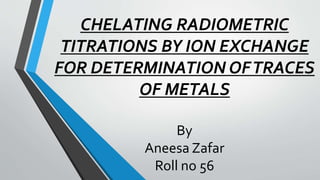
CHELATING RADIOMETRIC TITRATIONS BY ION EXCHANGE FOR DETERMINATION OF TRACES OF METALS
- 1. CHELATING RADIOMETRIC TITRATIONS BY ION EXCHANGE FOR DETERMINATION OFTRACES OF METALS By Aneesa Zafar Roll no 56
- 2. Some BasicTerms • Titration and its elements • RadiometricTitration • Types Of RMT I. Titration based upon Precipitate Formation II. Titration based upon Complex Formation III. Titration based upon Redox Reaction IV.Titration in Non-aqueous Media
- 3. Precipitation titrations • the second phase is a precipitate, • the end-point can be determined by the appearance of the activity in the aqueous phase, or by its disappearance from the aqueous phase, • Precipitation titrations are difficult to apply, because of necessity for handling precipitates, to less than milligram amounts, impossible at the submicrogram level. Complexometric titrations • formation of metal chelates which can be separated from the unreacted metal ions by solvent extraction. • The end-point is determined similarly from the change in activity either of the aqueous phase or of the organic phase. • far more sensitive, but has been applied only to a limited number of determinations.
- 4. RADIOMETRICTITRATIONS USING EDTA • EDTA titrations are widely used for determination of many metals. • Determination of submicrogram amounts of metals • Formation of negatively charged or neutral chelates which can easily be separated from the excess of the unreacted metal ions on a cation exchanger. • The end-point is determined from the activities of the eluates obtained. • In radiometric titration, isotopic and non-isotopic tracer can be used. • the determination of metals forming very stable chelates (e.g., Co (III), Zr (IV) , Fe(lI), In(IIl),Th (IV), etc.) can be carried out at pH 2-3 using 10^-6 to 10^-7M EDTA solutions.
- 5. DETERMINATION OFTRACES OF INDIUM USING ISOTOPICTRACER Procedure: • The pH of a series of equal, known volumes of analysed solution of indium (2.0 ml containing about 1 µg/ml), labelled with a known amount of radio- indium (t(1/2) = 50 days), is adjusted approximately to a value of 2-3. • Any iron (III) present, which can interfere, is reduced to iron(II) by adding 2 drops of 10% ascorbic acid. • The solutions thus prepared are carefully mixed with known, increasing amounts of titrating solution (lO+M EDTA) and are simultaneously passed through a series of cation-exchanger columns. • Each value of activity measured represents a point on the titration curve
- 7. Curve Indium Added (µg) Radioindium added (µg) Total Indium present (µg) Total Indium found (µg) A 0.00 1.02 1.02 1.00 B 0.22 1.02 1.24 1.23 C 0.44 1.02 1.46 1.46 D 0.88 1.02 1.90 1.94 Traces of indium uni- and bivalent metal cations will not interfere, because of their lower stability constants.This has been verified in the present work. However, titrations using isotopic tracers are limited to instances where suitable radioisotopes are available.
- 8. DETERMINATION OFTRACES OF COBALT USING NON-ISOTOPICTRACER • Because of much higher stability with EDTA of the cobalt (lI) complex than of the indium complex it is possible to use radio-indium as non-isotopic tracer for the determination of traces of cobalt. • Procedure: • To the series of solutions containing equal, known volumes of the analysed solution (slightly acid), known, increasing amounts of EDTA (10^-5 M) are added. • Each of these solutions is carefully mixed in a polyethylene flask with 0.5 ml of 0.0lM aqueous ammonia containing 1.5% hydrogen peroxide. • The pH of the solutions thus prepared should be 6-8. • The solutions are heated on a boiling water bath for 5 min (formation of Co(III)--EDTA complex). • After cooling to room temperature the pH of all the solutions is readjusted to approximately 2-3, and the radio-indium tracer is added.The remainder of the procedure is carried out as before.
- 10. Curve Cobalt Added(µg) Cobalt found (µg) A 0.00 0.00 B 0.29 0.27 C 0.58 0.56 The non-isotopic tracer most suitable for achieving the highest selectivity can also be chosen using the stability constants of the EDTA complexes.The stability constant of the EDTA complex of the tracer must be lower than that of the metal to be determined, but higher than the stability constants of interfering metals which might be present. Compared with extractive titrations, radiometric titrations using EDTA have the advantage of high stability of the titrant even in very dilute solutions.